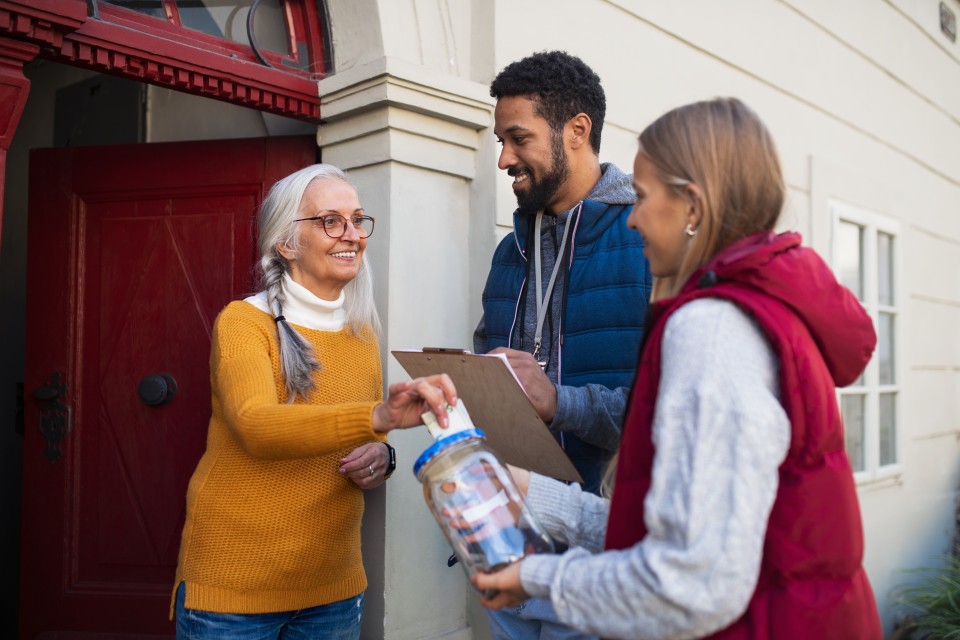
Have you ever considered integrating service-learning into your teaching, or wondered how service-learning experiences might benefit your students?
Consider this quote from an Educational Studies student taking ESHESA 2571S: Leadership in Community Service at Ohio State:
“Service-learning can help you become more aware of your own beliefs, prejudices, and views of the world. This is an ongoing process and service-learning helps facilitate experiencing something new that changes and broadens one's perspective, makes you reflect on the differences between your expectations and reality, and promotes active application of the new understanding.”
Service-learning is a high-impact practice that offers students and instructors opportunities to engage with community partners in unique and beneficial relationships. These relationships open up new and exciting learning pathways through integrated, hands-on experiences. By participating in service-learning courses, students can actively apply what they learn in real-world settings, learn new skills, develop social responsibility, and connect with community members they might otherwise not get to know. In turn, they do work that gives back to their communities and promotes the common good.
Creating a service-learning course may seem intimidating, but resources abound to assist you in building effective service-learning experiences. As you explore and plan, you’ll keep in mind three key elements: integration, engagement, and reflection.
Background
What is Service-Learning?
The National Service-Learning Clearinghouse defines service-learning as “a teaching and learning strategy that integrates meaningful community service with instruction and reflection to enrich the learning experience, teach civic responsibility, and strengthen communities” (Seifer & Connors, 2007). According to George D. Kuh, the leading architect of the high-impact practice movement, its purpose “is to give students direct experience with issues they are studying in the curriculum and with ongoing efforts to analyze and solve problems in the community” (2008. p. 34).
At Ohio State, service-learning involves student participation in an organized service activity made possible by a mutually beneficial campus-community partnership. All service-learning courses must:
- Meet an identified community need(s)
- Connect to specific learning outcomes for the course
- Provide structured time for students to reflect and connect their service experience to learning
Why Service-Learning?
Why should you consider developing a service-learning course? In short, they are unique in their capacity to provide reciprocal benefits to students and community partners, as well as to instructors.
Service-learning has a demonstrated impact on several important outcomes of an undergraduate education, including mindful and engaged citizenship. Students enrolled in service-learning courses have shown improvement in diversity outcomes such as “appreciation” and “acceptance” (Einfeld & Collins, 2008; Kilgo, 2012; Simons & Cleary, 2006), well-being in adulthood (Bowman et al., 2010), and identity development (Jones & Abes, 2004). Further research is required to better understand the effects of service-learning courses on student learning outcomes (see Kilgo et al., 2015) and the influence of the instructor role in the service-learning process.
Service-learning courses enable students to:

- Develop leadership, critical thinking, and interpersonal skills
- Grow knowledge of academic subjects
- Apply their learning to “real world” situations
- Expand their perspectives and world views
- Build skills for future employment
- Establish community connections and potential professional networks
- Cultivate a sense of personal efficacy and social responsibility
Service-learning courses enable community partners to:
- Strengthen relationships with the university
- Engage as co-educators with students to achieve goals and effect community change
- Leverage the enthusiasm and new perspectives students bring to a project
- Improve programming and services through student contributions
- Connect with potential volunteers or prospective employees
“Each year instructors at The Ohio State University include service-learning in over 80 courses to enrich the understanding of course content, broaden appreciation of the discipline, and enhance development of civic responsibility. Faculty engaged in community-based scholarship have increased opportunities not only to enrich teaching and integrate service, but also to design research to improve future learning and service outcomes.”
- Office of Service-Learning, The Ohio State University
Finally, service-learning courses enable you, as an instructor, to:
- Make a difference
Service-learning allows you and your students to see how your work and ideas have a practical application and impact beyond the classroom. - Connect to your passions
Creative service-learning projects may nurture your intellectual and civic interests in ways traditional classes and research may not. - Attract driven students
Students who seek out service-learning courses have unique life experiences and a commitment to their own learning. - Improve “town-gown” relations
Creating positive, reciprocal relationships with community partners helps to blur the boundaries between campus and community. - Publish in new ways
Service-learning and community-engaged research creates new knowledge and offers the opportunity to stand out in your field. - Diversify your CV
Teaching experience with community-based and service-learning is a meaningful addition to your tenure and promotion materials.
In Practice
Service-learning courses run the gamut in terms of their content and approach to community engagement. What your course looks like may depend largely on your subject, learning goals, and the needs of your community partner.
Some specific models of service-learning, drawn from Kerissa Heffernen (2001), include:
“Pure” Service-Learning
These courses are centered around the core idea of service to the community, volunteerism, and engaged citizenship. Students are sent out into the community to participate in service experiences, but not necessarily with a focus on any one discipline.
Discipline-Based
Students have a presence in the community throughout the semester and reflect regularly on their service experiences. Students’ reflections must draw connections to course content and the discipline as the foundation for their analysis of the issues at play.
Problem-Based
Students operate with your community partner as if they are “consultants” working for a “client” and attempting to solve a particular problem or meet a specific need. For example: architecture and interior design students design a community theater; education students develop early literacy programming for a city library; marketing students draft a promotional campaign for a local nonprofit; forestry students plan a new nature trail at a state park.
Capstone Course
Typically for majors or minors in a given discipline and offered to students in their final year, capstone courses ask learners to draw upon their coursework and combine it with relevant community service work, either to explore a new topic or to synthesize prior learning.
Service Internship
Students work as many as 10 to 20 hours a week in a community environment and are expected to produce work of value to the partner or site. Ongoing reflection is guided by the instructor and encourages learners to analyze their service experiences in line with theories or principles of their field or discipline.
Undergrad Community-Based Action Research
Like an independent study for students who are experienced in community work, this model is more advanced and mostly effective with smaller classes or groups of students. Students work closely with the instructor to learn research methods while advocating for the community.
No matter your approach, all service-learning courses should be designed in an integrated way, with ongoing community engagement, and with ample reflection opportunities for students. You may be tempted to take an existing course and simply add a service or community-based component to it. This is not recommended, however, as the service component will not be fully integrated into the learning goals and outcomes of your course.
Integration

What do we mean by “fully integrated”? Service-learning should be incorporated thoughtfully and intentionally in your overall course design. Integrating community engagement throughout the entirety of your course is essential for students to truly benefit from the unique characteristics of service-learning.
Plan a clearly defined service component that directly supports your learning goals, keeping service-learning central to your course structure, content, and assessment methods. This will facilitate a course experience in which students can use and build upon the lessons they learn through community involvement. By designing your course with service-learning in mind, you better equip students to make connections between your learning goals and course activities, and between your academic field and the “real world.”
Positive relationships with community partners are instrumental to the success of service-learning courses. As you plan your course, thoughtfully consider which local organizations, such as government or nonprofit agencies, would be ideal partners in meeting both a community need and your course learning outcomes.
Since service-learning courses typically call out community action goals in addition to learning goals, it’s helpful to collaborate with your partner to plan the service-learning component of your course. For example, you may give the partnering organization a voice by involving them in aspects such as “project planning, student orientation, guest lectures, site visits, class discussions, progress reports, final presentations, and project evaluation” (Vanderbilt University, 2022). Collaborating closely with your partner will also benefit students, allowing them to form deeper understandings of the connections between your course content, their service experiences, and the needs of the community.
Engagement
If you integrate service-learning fully in your course, it follows that community-based activities will be ongoing throughout the semester. The most meaningful and successful interactions between students and community partners will result from sustained and continual involvement. Although a one-time event, such as a “day of service,” can be beneficial to a community, it does not provide the relationship-building, skills development, and reflection opportunities that are typically embodied by a service-learning course.
Ongoing opportunities for engagement and service enable students to become familiar with the complex needs, cultures, and viewpoints of your partners and community. This results in richer experiences, perspectives, and understanding of the community, and of the concept of service itself. Furthermore, sustained involvement between students and your partner is more likely to lead to significant reciprocal benefits for all involved—another defining element of a successful service-learning course.
“Service-learning combines the best of active learning and citizenship by connecting course content with service projects that help the community. It is a powerful way of understanding course material by learning from experience.”
- Office of Service-Learning, The Ohio State University

Reflection
The third key component to consider when designing a service-learning course is reflection. For students to truly move toward new perspectives, they need to grapple with their time spent in the community.
Design intentional reflection questions for both in-class and out-of-class sessions. Your reflection questions should be grounded in your course goals and outcomes while encouraging students to recognize how their experiences align with their own expectations, challenge their perspectives and modes of thinking, or encourage future engagement. Effective reflection assignments allow students to process their community involvement in a safe yet intellectually challenging environment.
What types of activities and assignments will support your students to critically reflect on their experiences in your course?
Explore the sample Reflection Activities for Service-Learning Courses.
Resources and Support
If you’re new to service-learning or need assistance with developing your course, the Office of Service-Learning at Ohio State has numerous resources available. A cornerstone to these efforts is the Community-Based & Service-Learning Course Development Grants program where instructors can receive funds to develop a course. Part of this grant is the completion of the Course Design Institute, which leads you through a step-by-step creation of your course, along with content and assessment methods. If you’re interested specifically in integrating service-learning into your online course, check out these resources for online service-learning.
The Office of Service-Learning also provides individual consultations and assistance with course development, identification of community partners, and service placement and management.
Contact slearning@osu.edu.
Examples
Reflection Activities for Service-Learning Courses
Summary
Service-learning offers students and instructors unique opportunities to form mutually beneficial relationships with community partners. Participation in service-learning courses enables students to apply learning beyond the classroom, develop social responsibility, and give back to their communities.
To make your service-learning course a success, attend to three key principles:
- Integration: Service-learning should be incorporated intentionally in your overall course design, underpinning your course structure, content, and assessment methods.
- Engagement: Service-learning activities should be ongoing throughout your course and require regular interaction between students and community partners.
- Reflection: Frequent opportunities to reflect on community-based experiences and how they relate to course outcomes—as well as to students’ own expectations, perspectives and personal goals—are a core element of service-learning courses.
Consider these guiding questions as you plan your course:
- What community-based activities might align well with your course? What issues, problems, or needs might your students engage with solving?
- Which local organizations could you establish partnerships with to meet both a community need and your course goals and outcomes?
- How will you fully integrate a service-learning component into your course structure? What ongoing opportunities will you provide for students to interact in the community? What will your role be in managing this work and supporting the relationships with your community partner?
- What types of activities (e.g., journals, discussions, progress logs, portfolios) will best support your students to reflect on their service-learning experiences?
- What authentic assessments and assignments might be beneficial in demonstrating student learning, while also providing value to your community partner?
- How will you collect feedback from students and partners on the success of the service-learning experiences you planned?
References
Bowman, N., Brandenberger, J., Lapsley, D., Hill, P., & Quaranto, J. (2010). Serving in college, flourishing in adulthood: Does community engagement during the college years predict adult well-being? Applied Psychology: Health and Well-Being, 2(1), 14–34.
Einfeld, A., & Collins, D. (2008). The relationships between service-learning, social justice, multicultural competence, and civic engagement. Journal of College Student Development, 49(2), 95–109.
Jones, S. R., & Abes, E. S. (2004). Enduring influences of service-learning on college students’ identity development. Journal of College Student Development, 45(2), 149–166.
Kilgo, C. A. (2012). The estimated effects of service learning and undergraduate research on students’ intercultural effectiveness (Master’s thesis).
Kilgo, C. A., Ezell Sheets, J. K., & Pascarella, E. T. (2014). The link between high-impact practices and student learning: Some longitudinal evidence. Higher Education, 69, 509–525.
Kuh, G. D. (2008). High-impact educational practices: What they are, who has access to them, and why they matter. Association of American Colleges and Universities.
Seifer, S.D. & Connors, K. (2007). Faculty Toolkit for Service-Learning in Higher Education. National Service Learning Clearinghouse. https://docs.google.com/viewerng/viewer?url=https://community-wealth.org/sites/clone.community-wealth.org/files/downloads/tool-LSA-serv-learn.pdf
Simons, L., & Cleary, B. (2006). The influence of service learning on students’ personal and social development. College Teaching, 54(4), 307–319.
Vanderbilt University. (2002). Best Practices in Community Engaged Teaching. Center for Teaching. https://cft.vanderbilt.edu/guides-sub-pages/best-practices-in-community-engaged-teaching/#reflect

